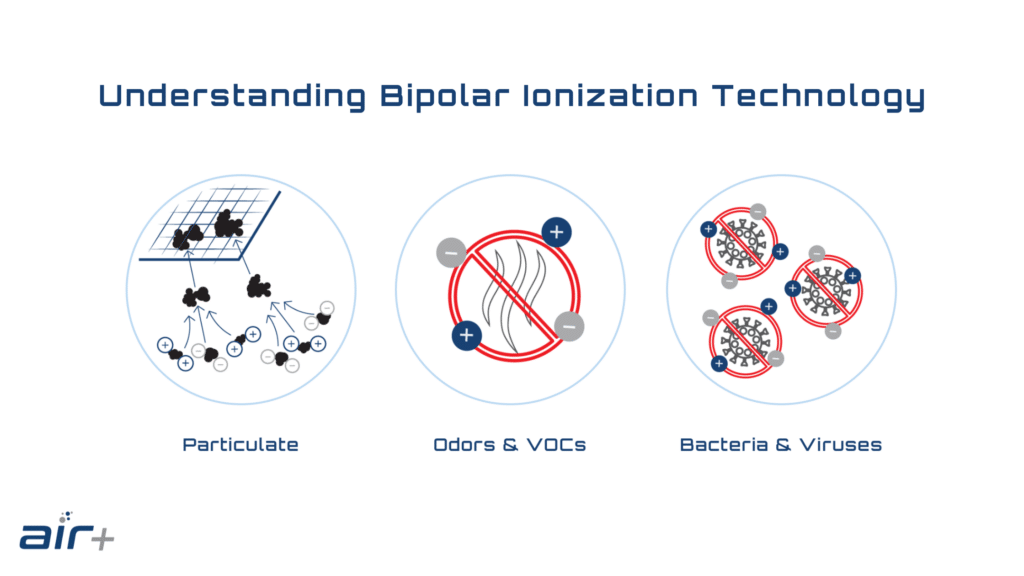It’s been well documented that Americans, on average, spend approximately 90% of their time indoors where some pollutants are often 2 to 5 times higher than typical outdoor concentrations. EPA.gov. The combined effects of outdoor air pollution and indoor air contaminants result in roughly 6.7 million premature deaths annually. State of Global Air (SoGA).
Understanding that the quality of indoor environments can significantly influence health, comfort, and productivity, there is a strong motivation to deliver high-performing air purification solutions. Among these, Bipolar Ionization (BPI) technology stands out, harnessing established electrical principles to effectively enhance Indoor Air Quality (IAQ).
What is Bipolar Ionization Technology?
Bipolar Ionization is a process that creates ions in the air. An electrical voltage potential is applied to an airflow causing molecules to gain or lose electrons resulting in the formation of charged atoms or molecules, referred to as ions. Ions are positively charged (cations) if they lose an electron, or negatively charged (anions) if they gain an electron. Bipolar denotes the creation of both positive and negative ions in the air.
How Does Bipolar Ionization Work?
These ions are dispersed into the air through the building’s central heating, ventilating and air conditioning (HVAC) system, resulting in an extremely efficient process. Once delivered to the occupied space, the ions dramatically improve air quality.
Particle Agglomeration: Oppositely charged ions attach themselves to suspended airborne particles such as dust, pollen, and mold spores causing them to agglomerate, or cluster together. The larger size and weight of these agglomerated particles causes them to settle out of the air more quickly, and be more effectively captured by the HVAC filter because air filters are more efficient at trapping larger particles.
VOC and Odor Neutralization: Ions can initiate a chemical reaction with certain VOCs and odors. For example, ionization can break down hydrogen sulfide (H2S) into water (H2O) and sulfur dioxide (SO2) or sulfate (SO4) commonly found in applications as severe as wastewater treatment plants. Ionization can also break down polycyclic aromatic hydrocarbons (PAHs) — the cancer-causing chemicals found in cigarette smoke prevalent in casinos. Ions are also capable of neutralizing body odor found in locker rooms and fitness centers, jet fuel fumes in airports, formaldehyde in morgues and even cannabis odors in a grow facility.
Virus and Bacteria Deactivation: Bipolar ionization technology can also deactivate infectious airborne pathogens such as SARS-CoV-2 and the Influenza virus. Ions disrupt surface proteins on bacteria and virus cell walls as the oxygen ions try to connect with the hydrogen present in the cells. Once the life-sustaining hydrogen is removed from the virus and bacteria cells, they become deactivated. Because of this, bipolar ionization technology has garnered great attention for its potential to reduce the transmission of infectious airborne diseases like COVID-19.
Addressing Safety and Misconceptions
It is important to address any misconceptions about the safety of bipolar ionization. Not all ionization systems are created equal. Some ionization technologies produce ozone as a byproduct, which can be harmful at relatively high levels. Modern systems designed with safety in mind are certified to UL2998, affirming their zero ozone emission status. It’s also important to note that ionizers that produce small amounts of ozone are no more harmful than ozone levels that naturally exist outdoors during the warm summer months. Air+ needlepoint ionizers are all validated to UL2998 for zero ozone emissions, standing out for their commitment to producing zero ozone.
Applications of Bipolar Ionization
The flexibility and efficacy of Bipolar Ionization technology make it suitable for a wide range of applications, from residential and commercial spaces such as schools, offices, and senior living, to more controlled environments like hospitals and laboratories. To explore the wide range of applications of Bipolar Ionization and gain further insight into the advantages of this versatile technology, visit the Air+ website.
Air+ purification systems leverage world-class bipolar ionization technology to address the needs of diverse spaces, offering educators, office managers, retail owners, and healthcare providers a reliable, modern solution to maintaining optimal indoor air conditions. All Air+ products are designed to be safe and effective at improving indoor air quality. Reach out to the experts at Air+ to learn more about BPI and to answer any further questions.
The Future of Bipolar Ionization
As we continue to prioritize indoor air quality, technologies like BPI will play a pivotal role in shaping healthier and safer indoor environments. Continuous innovations like auto-cleaning needlepoint ionizers, and streamlined integration with intelligent building systems have bipolar ionization poised to be the cornerstone of indoor air purification strategies.

